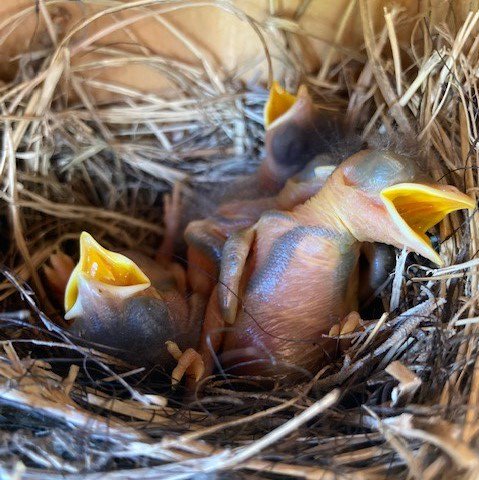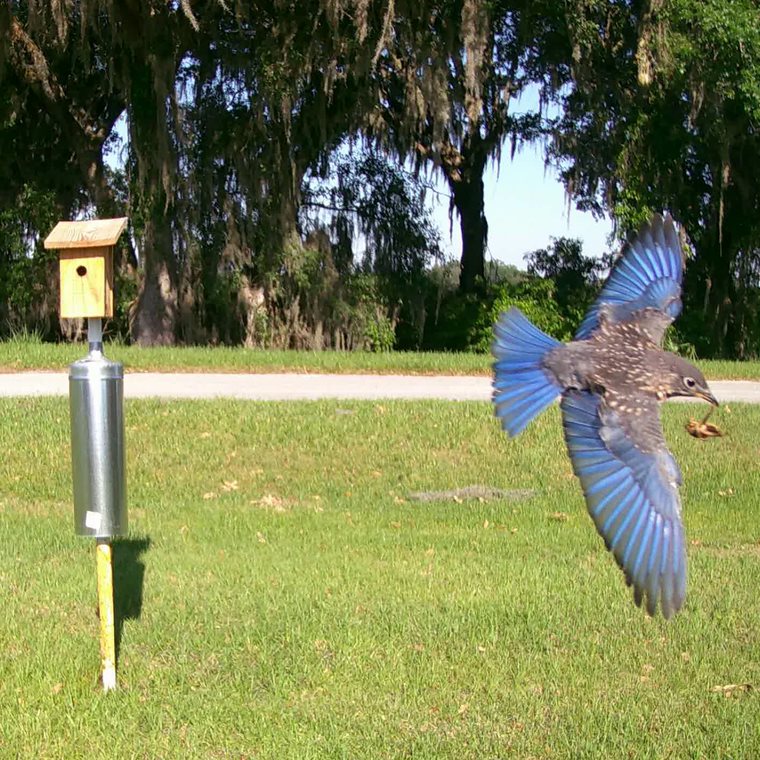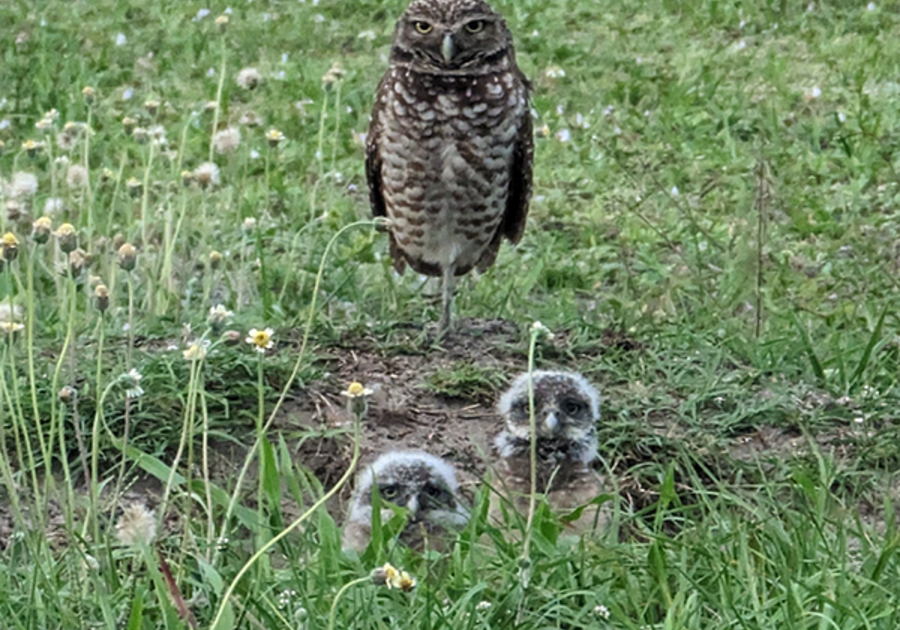No two moms’ parenting methods are alike, and the same can be said about motherhood in the animal kingdom.
To share some fun facts about animal moms frequently spotted in Florida, we went to the University of Florida experts.
 Burrowing owls are dedicated mothers
Burrowing owls are dedicated mothers
As we celebrate Mother's Day, the hardworking burrowing owl mothers deserve recognition, said Corey Callaghan, a UF/IFAS assistant professor of global ecology at Fort Lauderdale Research and Education Center.
“These fascinating birds exhibit dedicated parental care, with females solely responsible for incubation, while males provide food,” he said. “Interestingly, once burrowing owls find an area they like to nest in, they use it year after year, with 50 percent of females returning to within 200 meters of their previous nest burrow.”
One of the distinctive maternal traits of burrowing owl mothers is that they also play an essential role in hunting for their young once they reach about two weeks old, Callaghan said.
“As a species that exhibits parental care, burrowing owls provide an excellent example of how animals can teach us the value of dedication and nurturing their young ones,” he said.
 |  |
Mama Bluebird wants peace and quiet
Like the burrowing owl, most female songbirds are primarily responsible for incubation duties. This is true of the Eastern bluebird, a species Kathryn Sieving has been studying.
The male bluebird will sometimes feed the incubating female, so she won’t need a break. Later, the males work hard to help feed the nestlings after they hatch. But keeping the eggs warm requires a calm and well-fed mom bluebird.
“While incubating, female bluebirds must contend with urban noises, disturbances, and buzzing mosquitoes at their nest boxes,” said Sieving, a UF/IFAS wildlife ecologist who specializes in avian behavior. “Altogether, this can cause her to fidget so much her eggs get cold and don’t hatch.”
Hatching success is affected by both steady hums and intermittent noises — think ordinary traffic and a loud truck rolling past. Combine those disturbances with buzzing mosquitoes, and hatching success is at its lowest, Sieving said.
“It’s a lesson for the kids and dads out there: Protect mom’s rest so she can do better for the family,” Sieving said about the birds —and as a playful nod to humans, too. “No bugs, no noise, and if Dad can feed her and the kids often, this can extend her rest periods and, therefore, the kids’ well-being.”
Alligators: Don’t let the tough exterior fool you
Despite being large powerful predators, alligators are extremely protective mothers, said Frank Mazzotti, a professor of wildlife ecology at the UF/IFAS Fort Lauderdale Research and Education Center.
“Maternal care starts before eggs are laid and continue beyond when eggs hatch. Females equip eggs with food in the form of yolk sacs that give newly hatched babies a head start,” he said.
When it comes to maternal instincts, there is more to this fierce female than her extreme strength.
“Alligators, which have a bite force of 2,000 pounds per square inch, can gently roll an egg between their tongue and roof of their mouth, helping to crack the egg and release the hatchling,” Mazzotti said of a sometimes-necessary process.“Many times, hatchling alligators are scooped up by mom in her mouth and carried to a nearby pond or other nursery habitats.”
Baby alligators can stay with their mom for up to 18 months. Throughout that time, the mom will respond to the baby’s distress calls.
Bat Maternity Season Is Underway
Motherhood through the eyes of a Florida biologist is simply astonishing, said Ken Gioeli, a natural resources and environment agent at UF/IFAS Extension St. Lucie County.
“Just look at our nocturnal mothers, they have a ‘wild life’ at night. Mama bats, for example, give birth to pups upside down,” he said.“The pup will cling to the mother’s fur and move into position to begin suckling. This bonding time is important during maternity season, which runs from April through August in Florida.”
Eventually, the mama bat flies off to find insects for her own nourishment, Gioelisaid. “When she returns, she must find her pup to enable it to nurse again. Pups would literally starve to death if separated from their mothers because they are completely dependent on mom’s milk for the first few months of their lives.”
This is why it is critically important that mother bats not separate from their pups during maternity season. Gioeli stresses that using exclusion devices when bats are living in buildings can be deadly for the species.
Termitequeens’ Reign Promotes Smart Growth
In the termite world, initial parental love is mandatory to produce a successful colony, said Thomas Chouvenc, an assistant professor of urban entomology at the UF/IFAS Fort Lauderdale Research and Education Center.
The termite queen makes parenting a family affair, sharing all parenting responsibilities of child rearing with the king.
“During the early colony growth, the queen and the king provide care and dedication to their first few eggs, so that they can develop successfully into workers,” Chouvencsaid.
Once workers are produced, the queen and king focus completely on reproduction. Once the colony is established, the queen can lay thousands of eggs per day, making a termite queen one of the most productive mothers in the animal kingdom.
“To make matters more interesting, termite queens and kings are the most dedicated parents at first sight, until they become fully dependent on their own offspring,” he said.“Without the initial investment of parental care from the mother and the father, the colony would fail to establish.”
Manatee moms, with baby in tow
When it comes to sea creatures, manatee moms are some of the most attentive around, said Maia McGuire, UF/IFAS Extension Associate director for Florida Sea Grant.
“Manatees are very social creatures, and babies spend two years with their moms nursing and learning the ropes,” she said. But those learned behaviors can be for better or for worse.
“It’s been documented that manatees return to the same place year after year,” McGuire said. “They may frequent an area where entanglement in things like crab traps is more of a risk, or there could be a shift in food abundance or the warm water source.”
It’s especially important that humans let manatee mothers do the training, though.
“Don't offer manatees food or water,” McGuire said. “This trains them to approach docks, which could make them vulnerable to being hit by a boat. We also don’t want people touching or getting between a mama manatee and her calf – that tail is powerful.”
| ABOUT UF/IFAS |
| The mission of the University of Florida Institute of Food and Agricultural Sciences(UF/IFAS) is to develop knowledge relevant to agricultural, human, and natural resources and to make that knowledge available to sustain and enhance the quality of human life. With more than a dozen research facilities, 67 county Extension offices, and award-winning students and faculty in the UF College of Agricultural and Life Sciences, UF/IFAS brings science-based solutions to the state’s agricultural and natural resources industries and all Florida residents. |


